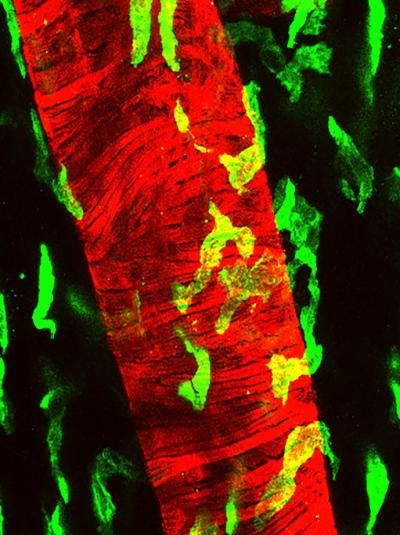Key to artery health lies in LYVE-1 macrophage

Macrophages coat the surface of blood vessel to maintain their structure and function. Green: macrophage; Red: blood vessel. Credit: Dr. Veronique Angeli
A team of researchers at NUS Medicine, led by Associate Professor Veronique Angeli, has identified a population of cells called macrophages that coat the outer walls of healthy arteries and express a protein called LYVE-1.
The researchers found that when these cells were absent, arteries accumulate collagen and lose their elasticity, becoming stiff and inflexible.
These findings suggested that the macrophages protect our arteries from becoming stiff, a concept that the team proceeded to prove.
They showed that the macrophages interact with another type of cell residing in the artery called smooth muscle cells, which produce collagen. The interaction between the two types of cell reduces the production of collagen by the smooth muscle cells.
Associate Professor Angeli and team showed that the LYVE-1 protein on the macrophages is actually responsible for this protective effect.
LYVE-1 binds to a molecule called hyaluronan expressed at the surface of smooth muscle cells and this interaction is required for the degradation of collagen by an enzyme called matrix metalloproteinase 9 (MMP-9).
The work has clinical implications for both aging and cardiovascular diseases because arterial stiffness is associated with aging and precedes cardiovascular diseases such as atherosclerosis and aneurysm.
This knowledge should help in the development of new treatments or the improvement of existing treatments for arterial diseases.
Media Contact
More Information:
http://dx.doi.org/10.1016/j.immuni.2018.06.008All latest news from the category: Health and Medicine
This subject area encompasses research and studies in the field of human medicine.
Among the wide-ranging list of topics covered here are anesthesiology, anatomy, surgery, human genetics, hygiene and environmental medicine, internal medicine, neurology, pharmacology, physiology, urology and dental medicine.
Newest articles

High-energy-density aqueous battery based on halogen multi-electron transfer
Traditional non-aqueous lithium-ion batteries have a high energy density, but their safety is compromised due to the flammable organic electrolytes they utilize. Aqueous batteries use water as the solvent for…

First-ever combined heart pump and pig kidney transplant
…gives new hope to patient with terminal illness. Surgeons at NYU Langone Health performed the first-ever combined mechanical heart pump and gene-edited pig kidney transplant surgery in a 54-year-old woman…

Biophysics: Testing how well biomarkers work
LMU researchers have developed a method to determine how reliably target proteins can be labeled using super-resolution fluorescence microscopy. Modern microscopy techniques make it possible to examine the inner workings…





















